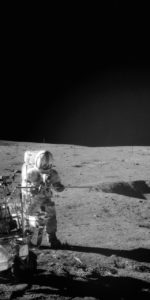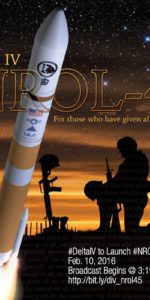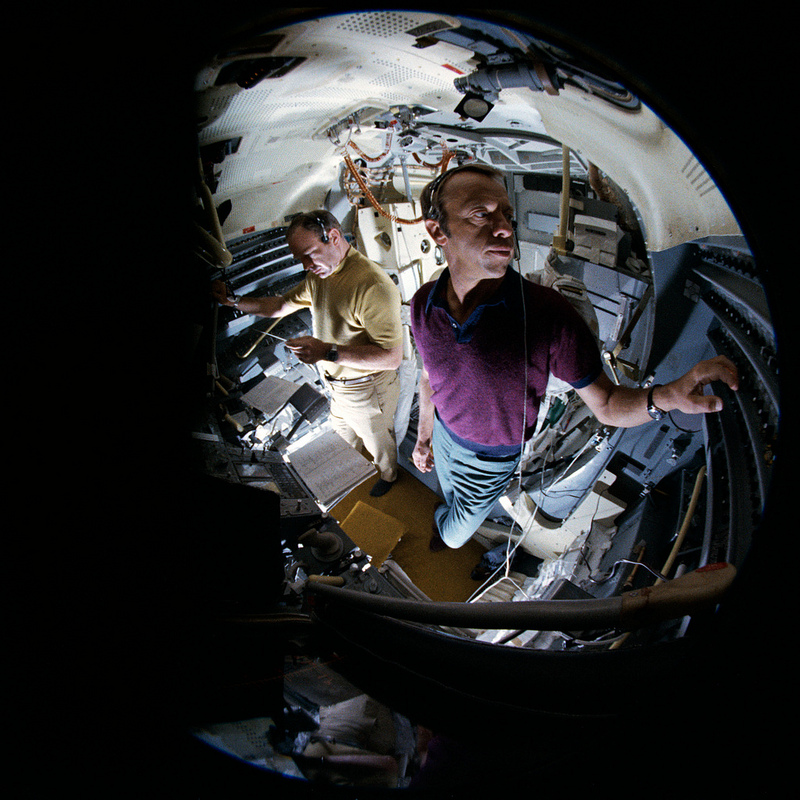
A few hours after leaving Earth on 31 January 1971—45 years ago, this week—Apollo 14 seemed a charmed mission-in-progress, providing a stark contrast with its immediate predecessor, the ill-fated Apollo 13. As outlined in yesterday’s AmericaSpace history article, Commander Al Shepard, Command Module Pilot (CMP) Stu Roosa, and Lunar Module Pilot (LMP) Ed Mitchell were tasked to almost repeat what the Apollo 13 would have done: executing a pinpoint landing in the Moon’s Fra Mauro foothills and hopefully revealing geological clues about the origin of our closest celestial neighbor. Before that, however, Roosa had to perform the Transposition & Docking maneuver, extracting the Lunar Module (LM), which the crew had named “Antares,” from the spent S-IVB third stage of their Saturn V booster, and beginning their long journey to the Moon.
And it was here that Apollo 14’s problems really began.
With pinpoint precision, Roosa guided the docking probe of the Command and Service Module (CSM), which the astronauts had named “Kitty Hawk,” into the cone atop the roof of Antares’ ascent stage, and all three men waited for three capture latches to signify a soft docking, after which they would retract the docking probe and pull the spacecraft together in a metallic embrace. The soft dock, however, never came. Perplexed, Roosa pulled away, informed Mission Control in Houston, Texas, then tried a second time. Again, there was no success. In Mission Control, there was similar confusion: for the mechanical latches needed no electrical power to operate, no pneumatic pressure or drive—they were supposed to click into place and lock. Huddled around a console, flight controllers and managers speculated that maybe a piece of debris, or even dirt, could be lodged inside the mechanism. Their consensus was that Roosa should try again.
Roosa did try again … and again, and again. No fewer than five attempts were made to “soft dock” with Antares, all of them fruitless. More worryingly, every time he maneuvered Kitty Hawk toward the lander, he was consuming more and more of the precious fuel which would be needed later in the mission. Shepard was becoming increasingly irritated, reporting “No joy” after each attempt. At length, he offered to depressurize the command module’s cabin, open the apex hatch, and withdraw the probe into the cabin to determine what was afoot. When Roosa had moved Kitty Hawk up to Antares with the tunnel open, Shepard would then have poked out his suited arms to align the two spacecraft for hard docking. Mission Control turned him down flat, declaring that such an exercise was too risky.
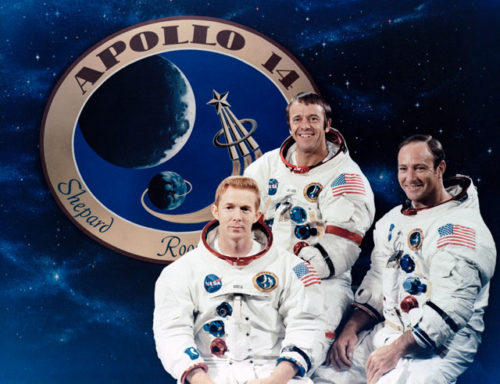
Instead, they advocated having Roosa come in harder and faster, ramming the probe into the docking cone and hopefully allowing the capture latches to “telescope” into position from the impact. Backup crewman Gene Cernan also advised them to push the retract switch a split-second before the two craft touched, thereby using the probe only to align the two collars. “That would drive Kitty Hawk hard up against Antares,” wrote Shepard, “and hold it there long enough to engage the 12 latches of the docking rings directly. If the smaller latches, which normally made the first connection, were faulty, then they could be bypassed and a hard dock achieved.” Aware of the dwindling supplies of propellant, Roosa asked for a fuel status reading from Mission Control and was advised to make one more docking attempt before that was “re-evaluated.” From his seat, Shepard had by this point had enough of gentle efforts to capture the lander and conserve fuel. It was time to push the throttle full forward. Turning to his command module pilot, he told Roosa: “Just forget about conserving fuel. This time, juice it!”
Minutes later, as some cautious managers in Mission Control continued to debate whether or not to cancel the flight, Roosa juiced it and the two craft came together. A welcoming cacaphony of clacks sounded through Kitty Hawk’s cabin, and when Shepard announced success, applause broke out in Houston. However, they were still not out of the woods. It would later be determined that dust or debris had indeed prevented a soft docking, but the fear remained that a similar problem could arise as Shepard and Mitchell rose from the Moon to redock in a few days’ time. Until the problem could be properly understood, and assurances received that disaster would not befall Apollo 14 in lunar orbit, the landing remained in question. The new head of Flight Operations, Sigurd Sjoberg, who had replaced Chris Kraft the previous year, told his troops that he wanted to be sure “that this thing is indeed satisfactory for docking, again, before we commit to the Moon landing.”
By now, the astronauts had been awake for 19 hours and were directed to get some sleep. That did not, however, inhibit Mitchell from conducting an unusual task during what he already expected would be his one and only spaceflight. For some time, he had been fascinated by the mysteries of extrasensory perception (ESP)—for which he felt neither religion or science provided a satisfactory explanation—and a few weeks before launch, he and some acquaintances had agreed to perform an experiment. Forty-five minutes into each sleep period, during the flight to and from the Moon, he would attempt to transmit thoughts from space. He started on the very first night. From within his sleeping bag, and by the glimmer of a flashlight, Mitchell pulled out a clipboard on which were written a series of random numbers, each one designating a typical ESP symbol.
“Mitchell chose a number,” wrote Andrew Chaikin in his book A Man on the Moon, “and then, with intense concentration, imagined the corresponding symbol for several seconds. He repeated the process several times, with different numbers, knowing that on Earth, four men were sitting in silence, trying to see the pictures in their minds.” In fact, Stu Roosa saw Mitchell’s flashlight during the first night’s sleep period and did not think to ask him about it the following morning. Not until after the mission, whilst reading the newspaper, would Shepard learn of Mitchell’s experiment.
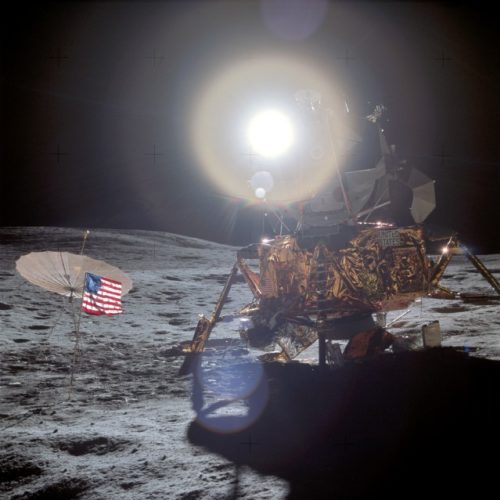
With the exception of the lingering worry about the docking mechanism, the remainder of Apollo 14’s cruise to the Moon was uneventful. As it drew closer, the astronauts began to discern traces of greys and browns—totally different to the bright object that they had known for all of their lives. Eighty-two hours after launch, Roosa fired the big Service Propulsion System (SPS) engine to drop them into an elliptical orbit with a low point of just nine miles (15 km) above the surface. This maneuver essentially eliminated the need for Antares to perform the early stages of descent and represented a refinement of mission techniques since Apollo 12. The propellant savings would give Shepard additional time to hover to find a suitable landing spot in the hummocky Fra Mauro.
By this time, experiments on Earth had satisfied mission controllers that the astronauts could repeat their “juice-it” maneuver to bring Kitty Hawk and Antares together if a similar problem arose in lunar orbit. The landing was officially back on the schedule. On their 12th circuit of the Moon, early on 5 February 1971, the lunar module undocked and began its descent. “I have Cone Crater, Triplet and Doublet!” Shepard radioed excitedly as the main surface targets came into view. The target point was close to Doublet. Despite their inherent knowledge of the landing site from months spent studying Lunar Orbiter photographs, the view was profound. Shepard called it a “wild place,” and Mitchell considered it to be “the most stark and desolate-looking piece of country I’ve ever seen.”
Apollo 14 was not out of the woods yet. In the center of Antares’ control panel was a red circular push button labelled “Abort.” Its purpose did not require a huge amount of explanation, except that pressing it would set in motion a chain of events to terminate the lunar landing, activating the ascent engine and boosting Shepard and Mitchell back up toward Roosa and Kitty Hawk. “The switch,” wrote Gene Kranz, one of the mission’s four flight directors, “had electrical contacts to issue signals to the LM engines, computer and abort electronics. When the abort switch for Apollo 14’s LM had been manufactured, a small piece of metal had been left in the switch. Now, in zero gravity, and with both crew and ground oblivious, this piece of metal was floating among the contacts of the switch, randomly making intermittent connections.”
Since the drama of Apollo 13, more than $15 million-worth of modifications had been incorporated into the Mission Operations Control Room, one of which included changes to help a controller to rapidly identify any change in status in critical spacecraft systems. From his chair as Antares’ control engineer for descent and landing, Dick Thorson glanced at his monitor and noticed a red light blink on; it seemed to imply that either Shepard or Mitchell had pushed the Abort button. Thorson was perplexed. Why would they do that? They had yet to begin their Powered Descent. Maybe there had been a telemetry patching error to the light panel on his console; a quick check, however, confirmed that everything was as it should be. As the engineer’s eyes widened, it became clear that, if this was for real, it signalled bad news for the landing at Fra Mauro. In the back room, two of Thorson’s colleagues, Hal Loden and Bob Carlton, also noticed the problem and suggested that one of the astronauts should tap the panel on which the Abort switch was located, in an effort to resolve the indication.
“Gerry,” Thorson called up Flight Director Gerry Griffin on the intercom loop, “I’m seeing an abort indication in the lunar module. Have the crew verify that the button is not depressed.”
Capcom Fred Haise duly passed the request up to Antares, and Mitchell tapped the panel with a flashlight. The abort light blinked off, then came back on again a few minutes later. “What’s wrong with this ship?” Shepard wondered. They were barely 90 minutes away from the initiation of Powered Descent, and the landing was temporarily waved off until a solution could be found. “Thorson’s dilemma was a thorny one,” explained Kranz in his autobiography, Failure Is Not An Option. “To land, we needed to bypass the switch, but if we had problems during landing, we needed the switch to abort. It was a hell of a risk-gain trade.” Thorson’s team identified a software “patch” for Antares’ computer, which would lock out both the Abort and Abort Stage switches, allowing the mission to continue. However, in an emergency, should Shepard and Mitchell need to perform an abort close to the surface, they would need to use the keyboard to manually initiate the abort program. Gerry Griffin was willing to accept the risk, confident that Shepard would probably do the same. He rescheduled the landing attempt for two hours’ time, on the next pass.
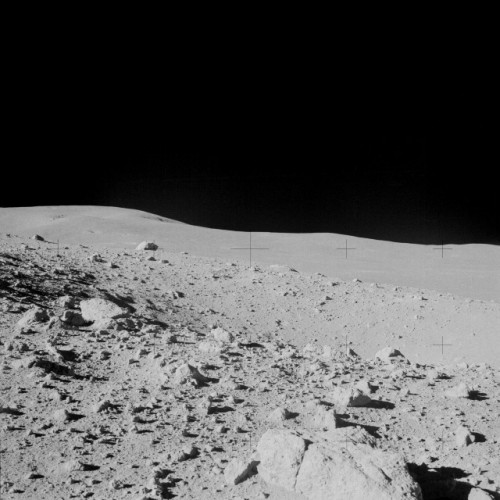
Key to this effort was the Draper Laboratory at Massachusetts Institute of Technology (MIT), which had developed the guidance and navigation systems for the Apollo spacecraft. Their engineers now shifted into high gear to wring out the software patch and make it work. Within the hour, a procedure had been devised, whereby the Abort switch could be bypassed when the descent engine was ignited and then re-enabled immediately thereafter. Amidst ratty communications with Antares, Haise radioed up instructions to Mitchell. First, the astronauts would start the descent engine at low power, using the acceleration to move the contaminating metal—probably a bit of solder—away from the switch contacts. As soon as Shepard fired the engine, Mitchell would input a string of 16 commands to enable steering and guidance, then another string of 16 more commands to disable the Abort program, then another 14 commands to lock into the landing radar and the descent software.
“This entire sequence,” wrote Kranz, “would occur as the crew was descending to the Moon. The mission now rested on an emergency patch to the flight software that was less than two hours old, had been simulated only once and was being performed by a crew that had never practiced it.” Nevertheless, when the engine lit, Kranz was astounded that Shepard had lost nothing of his sharpness and marvelous calmness as the instructions were entered into Antares’ computer. As the engine climbed steadily toward 10 percent thrust, Thorson monitored his display and saw no evidence that the Abort switch had been activated. So far, the mission was back on track.
“Thank you, Houston,” radioed Shepard. “Nice job down there!”
In his biography of Shepard, Neal Thompson related the singular contribution of one young MIT programmer, Don Eyles, who had helped to design Antares’ software. Eyles recalled being shocked from sleep as an Air Force car screeched to a halt outside his apartment at two in the morning and a uniformed officer hammered on his door. He was told that he had 90 minutes to come up with a solution for Apollo 14’s problems. Eyles threw a jacket over his pyjamas and was driven to his nearby lab to create, virtually from scratch, a substitute program to eliminate Antares’ faulty abort signal.
A few minutes into the powered descent, another problem reared its head. Both astronauts were now feeling positively snakebitten. This time, it was the landing radar—the device upon which Shepard and Mitchell would depend to feed them accurate altitude and rate of descent data as they headed for Fra Mauro. The trajectory data from Mission Control could include errors as great as 0.6 miles (1 km), making the radar indispensable. Guidance Officer Will Presley began to wonder why the radar had not locked-on. At first, he advised Griffin to continue the descent, but knew that he would need to call an abort if the radar did not kick in within the next 60 seconds.
From aboard the lander, Mitchell was irritated by the long delay in the radar acquiring the surface. “C’mon, radar,” he repeated quietly to himself. At length, Dick Thorson, upon whose shoulders fell the responsibility for the radar, suggested cycling its circuit breaker. When Fred Haise passed up the request, Antares was less than 4.3 miles (seven km) above the surface—if the radar did not come on by 1.8 miles (three km) or so, flight rules demanded that the landing be aborted—and Mitchell could scarcely hide the urgency in his tone: “Come on!”
Shepard plucked out the circuit breaker, cutting its power, then jammed it back into place. “Hell, it works with my toaster,” Mitchell quipped. Thankfully, this did the trick and a stream of radar data began flowing into the computer. By the time they reached an altitude of a couple of thousand metres, they could see Cone Crater off to the right, embedded in the crest of a ridge. They passed low over the ridge, heading for their target near Doublet.
“Fat as a goose!” Shepard exulted as he guided Antares toward a perfect touchdown, 174 feet (53 meters) from the intended spot—closer to target than Neil Armstrong or even Pete Conrad had achieved. The Lunar Contact light glimmered blue at 4:17 a.m. EST on 5 February 1971. It was the third time humans had made landfall on an alien body, and Shepard and Mitchell were electrified: primed and ready to begin the expansive program of exploration at Fra Mauro which had been cruelly denied to Apollo 13.
This is part of a series of history articles, which will appear each weekend, barring any major news stories. Next week’s articles will explore Apollo 14’s mission of exploration whilst in lunar orbit and on the Moon’s surface.
Be sure to “Like” AmericaSpace on Facebook and follow us on Twitter: @AmericaSpace




